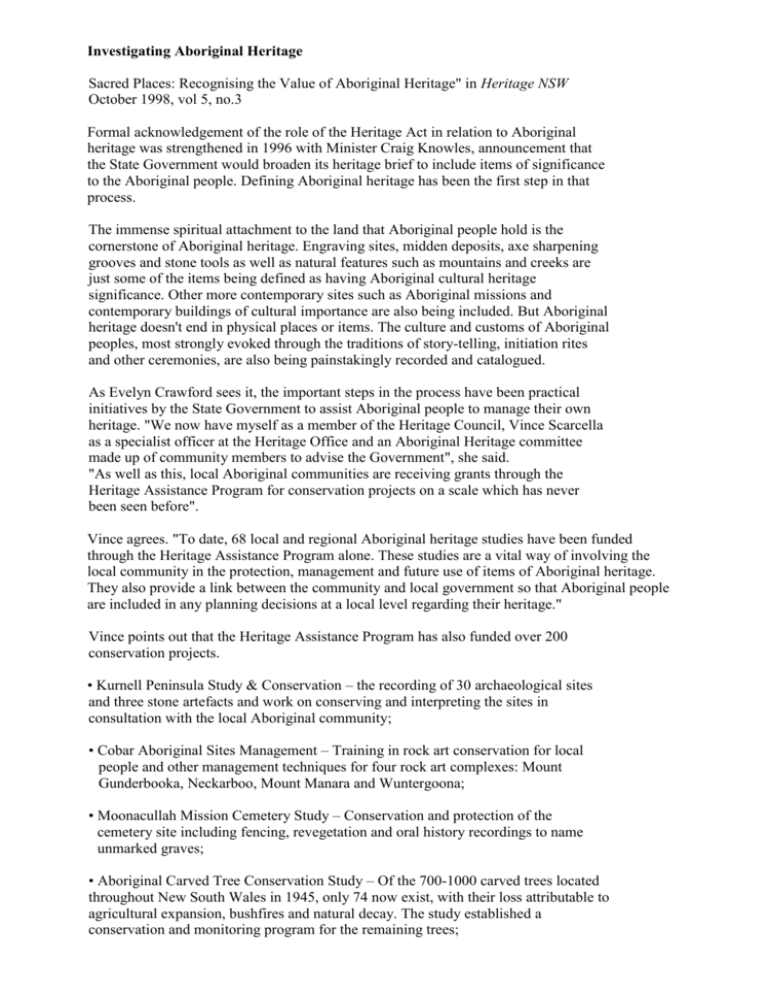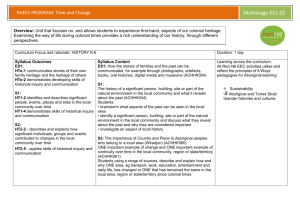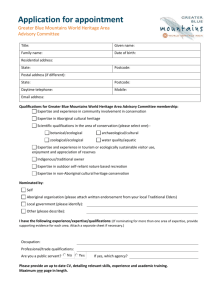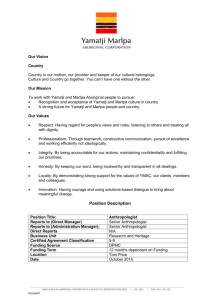wa3_maherho - Teaching Heritage
advertisement

Investigating Aboriginal Heritage Sacred Places: Recognising the Value of Aboriginal Heritage" in Heritage NSW October 1998, vol 5, no.3 Formal acknowledgement of the role of the Heritage Act in relation to Aboriginal heritage was strengthened in 1996 with Minister Craig Knowles, announcement that the State Government would broaden its heritage brief to include items of significance to the Aboriginal people. Defining Aboriginal heritage has been the first step in that process. The immense spiritual attachment to the land that Aboriginal people hold is the cornerstone of Aboriginal heritage. Engraving sites, midden deposits, axe sharpening grooves and stone tools as well as natural features such as mountains and creeks are just some of the items being defined as having Aboriginal cultural heritage significance. Other more contemporary sites such as Aboriginal missions and contemporary buildings of cultural importance are also being included. But Aboriginal heritage doesn't end in physical places or items. The culture and customs of Aboriginal peoples, most strongly evoked through the traditions of story-telling, initiation rites and other ceremonies, are also being painstakingly recorded and catalogued. As Evelyn Crawford sees it, the important steps in the process have been practical initiatives by the State Government to assist Aboriginal people to manage their own heritage. "We now have myself as a member of the Heritage Council, Vince Scarcella as a specialist officer at the Heritage Office and an Aboriginal Heritage committee made up of community members to advise the Government", she said. "As well as this, local Aboriginal communities are receiving grants through the Heritage Assistance Program for conservation projects on a scale which has never been seen before". Vince agrees. "To date, 68 local and regional Aboriginal heritage studies have been funded through the Heritage Assistance Program alone. These studies are a vital way of involving the local community in the protection, management and future use of items of Aboriginal heritage. They also provide a link between the community and local government so that Aboriginal people are included in any planning decisions at a local level regarding their heritage." Vince points out that the Heritage Assistance Program has also funded over 200 conservation projects. • Kurnell Peninsula Study & Conservation – the recording of 30 archaeological sites and three stone artefacts and work on conserving and interpreting the sites in consultation with the local Aboriginal community; • Cobar Aboriginal Sites Management – Training in rock art conservation for local people and other management techniques for four rock art complexes: Mount Gunderbooka, Neckarboo, Mount Manara and Wuntergoona; • Moonacullah Mission Cemetery Study – Conservation and protection of the cemetery site including fencing, revegetation and oral history recordings to name unmarked graves; • Aboriginal Carved Tree Conservation Study – Of the 700-1000 carved trees located throughout New South Wales in 1945, only 74 now exist, with their loss attributable to agricultural expansion, bushfires and natural decay. The study established a conservation and monitoring program for the remaining trees; • Wallaga Lake Oral History Project - Recordings of the oral histories of the Wallaga Lake people to hand down to future generations and assist in the management of local Aboriginal sites. Evelyn Maher is positive about the future of Aboriginal heritage conservation. ‘I really do feel there is a commitment by the government and out there in the community to recognise the worth of Aboriginal heritage and this is a reflection of the wider process of reconciliation’. Who is responsible for Aboriginal Heritage? Aboriginal people are the cultural owners and managers of information relating to their heritage. Information relating to Aboriginal history and heritage provided by members of any Aboriginal community must be treated with respect for the informant, and any agreement regarding access and/or confidentiality should be honored. reproduced with permission of the NSW Heritage Office









